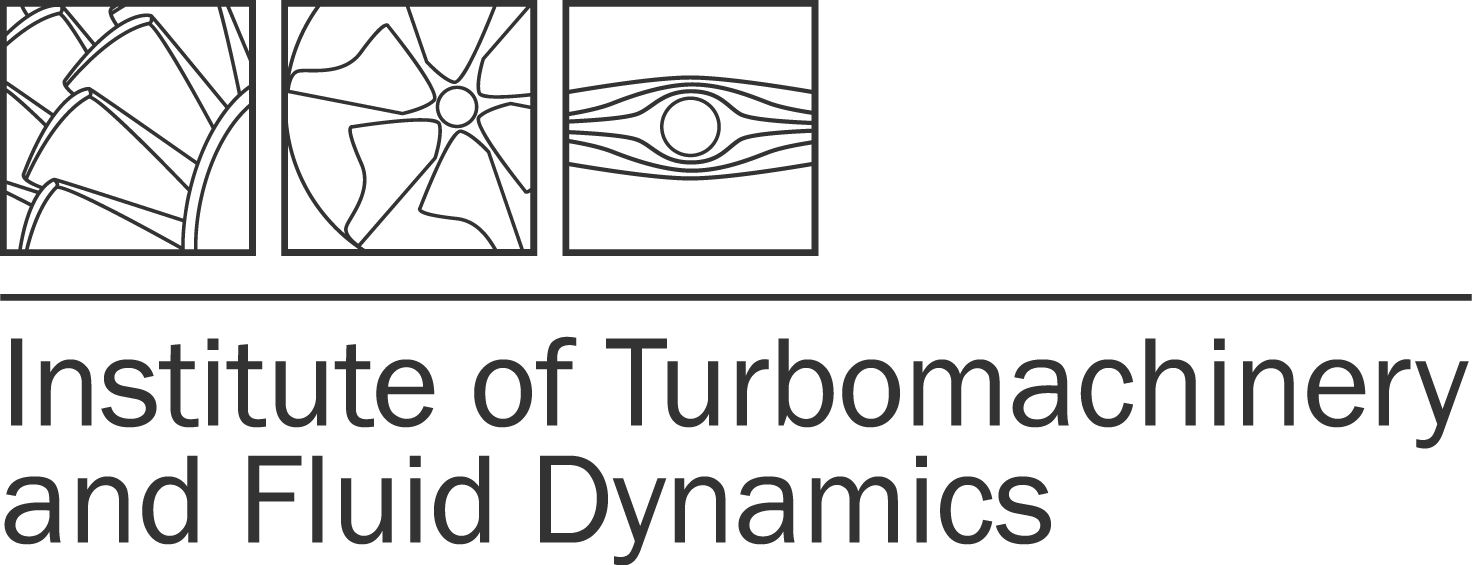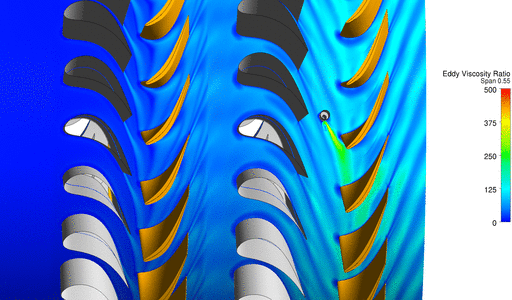Description
In most cases CFD is based on the Navier-Stokes equations. For their application in engineering related topics the complexity of the full Navier-Stokes equation is reduced to the Euler or potential equation. Dealing with the modelling of turbulent flows, turbulent quantities are described statistically by the Reynolds-Averages Navier-Stokes (RANS) equations and the use of turbulence models. Direct Numerical Simulations (DNS) and Large Eddy Simulations (LES) support the numerical resolution of small-scale turbulent fluctuations. However, these methods require considerably more computational resources.
At the Institute of Turbomachinery and Fluid Dynamics CFD is applied to the design and analysis of turbomachines. Furthermore, LES and DNS are exercised when investigating fluid mechanical principles.
Depending on the task different specialized CFD tools are available. In order to qualify the next generation of scientists and young engineers, a CFD workshop for students takes place each semester.
Field of Application
- Turbomachinery
- Wind energy
- Medical engineering
- Procedural fluid flows
Software Packages
-
Adapco StarCCM+
StarCCM+ is a commercial solver that is based on a finite volume method. The main applications for StarCCM+ at TFD are medical engineering subjects such as two-phase flows or the flow through porous materials. For two-phase flows the Volume-of-Fluid method (VoF) is used.
-
ANSYS CFX
CFX is a commercial solver for single- and multi-phase flows. At TFD, CFX is used for the simulation of exhaust gas turbochargers, axial turbo-machines and general fluid mechanics tasks.
-
FLOWer
FLOWer is a RANS-solver for structured grids. It was designed by German Aerospace Centre (DLR) and its main applications are external aerodynamics. FLOWer supports steady and unsteady flows and various turbulence models. The Chimera technology allows FLOWer to move various grids relative to each other and to map the fluid mechanic quantities of all grids.
-
LESSOCC2
LESOCC2 (Large-Eddy Simulation On Curvlinear Coordinates) is a solver that has been developed by Karlsruher Institute for Technology (KIT). LESOCC2 provides a solution of the three-dimensional incompressible Navier-Stokes equation. The unsteady flow is filtered and small scale turbulence is described by the Smagorinsky model.
-
MISES
MISES was developed by Massachusetts Institute of Technology (MIT). It is a tool for the design and analysis of turbomachine cascades. MISES uses a coupling of the viscous flow, such as boundary layers and the flow within the wakes, and the inviscid external flow. At TFD MISES is used for preliminary design; an additional model is added, which describes the effects of riblets on the boundary layer.
-
Numeca FINE Turbo
The commercial CFD program system FINE/Turbo by Numeca is used for the simulation of axial and radial turbomachines at the TFD. FINE/Turbo includes the automated grid-generator IGG/Autogrid, which is based on templates. This allows a fast meshing of complex three-dimensional geometries like non-axisymmetric endwalls, cooling air holes and cavities.
-
OpenFOAM
OpenFOAM is an open source program system, which is applicable to any continuum mechanics task. It is based on an unstructured finite volume method and includes a broad range of different solvers. The object-orientated program structure allows users to include additional solvers or routines. At the TFD OpenFOAM is used for LES and DNS.
-
TRACE
TRACE (Turbomachinery Research Aerodynamic Computational Environment) is a program system developed by the DLR and MTU Aero Engines. It is designed for three-dimensional unsteady simulations in turbomachines. At the TFD TRACE is used in various research projects and simulates all kinds of thermal turbomachines like compressors, specific test-rigs or entire turbines. As a project partner, the TFD is developing physical models for the prediction of turbulence and transition.
-
XFoil
XFoil is used to calculate aerodynamic profile properties like the friction or lift coefficient of wind energy turbine blades at the TFD. XFOIL is based on the panel method and was developed by MIT. It is applied for the design and analysis of subsonic aerodynamic profiles.
Contact


Deputy Chief Engineer
30823 Garbsen


Deputy Chief Engineer



![[Translate to English:] Bild - Strömungsfeld einer Windenergieanlage](https://www.tfd.uni-hannover.de/fileadmin/_processed_/b/8/csm_csm_12809_full_d33bfa12a9_b00b5e2ab1.png)
![[Translate to English:] Bild - Strömungsfeld einer Windenergieanlage](https://www.tfd.uni-hannover.de/fileadmin/_processed_/b/8/csm_csm_12809_full_d33bfa12a9_6e034cae3e.png)
![[Translate to English:] Bild - Strömungsfeld einer Windenergieanlage](https://www.tfd.uni-hannover.de/fileadmin/tfd/seitenvorlagen/Dateien/Leistungsspektrum/Simulation/Computational_Fluid_Dynamics/csm_12809_full_d33bfa12a9.png)
![[Translate to English:] Bild - Zeitverlauf eines Filmriss in einem peripheren Atemweg der menschlichen Lunge](https://www.tfd.uni-hannover.de/fileadmin/_processed_/1/0/csm_csm_film_rupture_timeserie_cropped_01_7f7d1dc6a1_2ebd064094.png)
![[Translate to English:] Bild - Zeitverlauf eines Filmriss in einem peripheren Atemweg der menschlichen Lunge](https://www.tfd.uni-hannover.de/fileadmin/tfd/seitenvorlagen/Dateien/Leistungsspektrum/Simulation/Computational_Fluid_Dynamics/csm_film_rupture_timeserie_cropped_01_7f7d1dc6a1.png)

